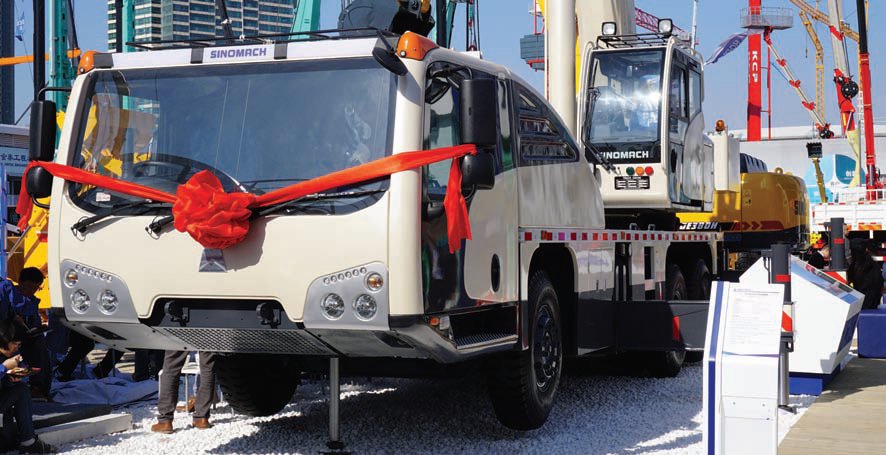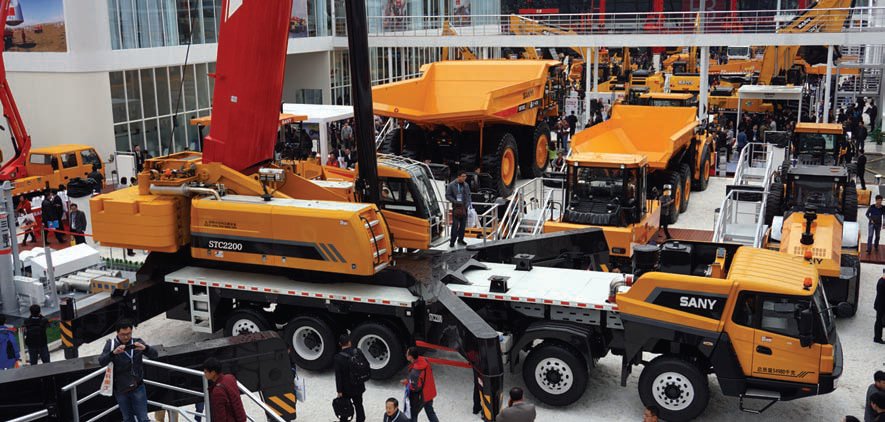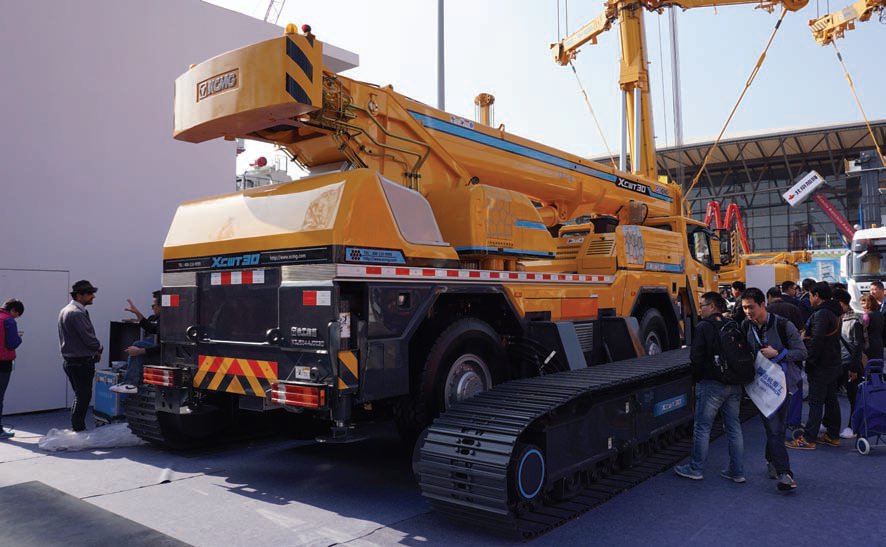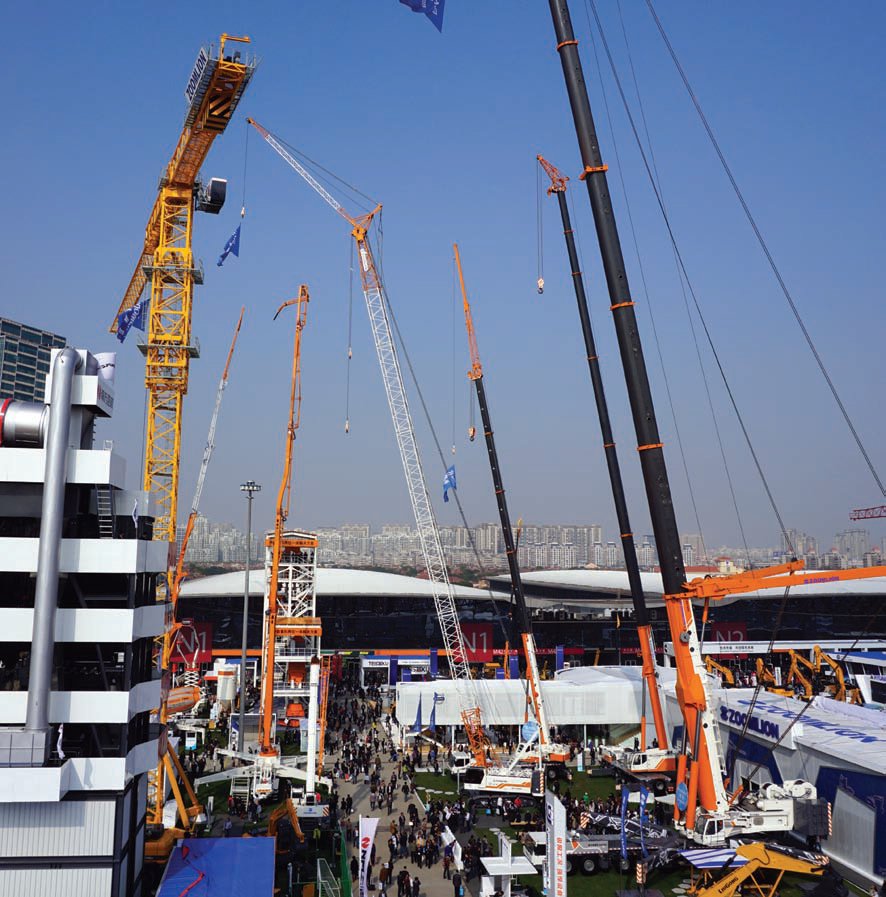Living with the new normal
16 February 2015China’s president Xi Jinping stressed in speeches in 2014 that the country—and its trading partners—would have to accept a ‘new normal’ of restrained growth, not the double digit percentage rates of previous decades. At Bauma China, Will North found manufacturers facing up to this new reality.
Sany's vice president for crawler cranes, Likun Wu, identifies three reasons for a slowdown in sales in the country's lifting industry: "The overall Chinese construction environment has slowed down. In certain markets and regions, some tonnages have been oversupplied to the market. And, on many construction projects, it is very hard to make money, as for the rental customers, their downstream customers have difficulty paying rental costs."
Su Zimeng, vice-chairman and secretary-general of China Construction Machinery Association (CCMA), discussed the state of the market at a presentation on the upcoming BICES show, taking place in Beijing this September.
Su said, "In 2014, with China's economic growth slowing gradually and the international political and economic situation becoming increasingly complex, the government has insisted on maintaining stable development. "Export volumes remain high.
According to statistics from the CCMA, in the first three quarters of 2014, exports were nearly $15bn, with year-on-year growth of 0.99%. In the downturn of the global construction machinery market, it's not easy for the construction machinery industry in our country to achieve steady development."
These broad economic factors -- of general malaise, of oversupply, of slow payment -- are seen by other manufacturers. Christoph Kleiner, managing director of Liebherr's Ehingen mobile crane division, notes that the heavy local competition in the market has meant that many global crane builders only see demand for their larger cranes. Here, Kleiner says, "Demand for this size of cranes, mainly driven by the energy sector, is low due to sufficient available crane capacity and reduced project activities."
Ken Lousberg, president of Terex China, agrees: "For the last two years, maybe a little longer, the overall construction market has been down. For us, that's had an impact on our crane business in China."
Manitowoc's executive vice president, Greater Asia Pacific, Raman Joshi says the slow down extends beyond China: "2014 has been a difficult year for us, for the economy in China and the rest of Asia." Like Liebherr's Kleiner, Tadano's executive officer, international sales, Shinichi Iimura, believes that there are specific problems with China's crane sector, beyond the problems of the global economy or the country's construction sector. The root cause, he says, is the irrational exuberance of the peak years: "Oversupply is a very soft word. Maybe, it is more a problem of aggressive production. There may be an increase in demand in 2015, but the Chinese manufacturers have a huge amount of [truck crane] stock to get rid of, several thousand units."
At the peak, both local and international analysts, having seen China's truck crane sales soar from 15,000 to 30,000 cranes a year, predicted this trend would continue, maybe reaching as high as 45,000 units a year. The reverse happened. The market for these, generally 8-12t, truck cranes collapsed.
Iimura is cautiously optimistic about an eventual return to growth: "The current government in China is trying to have a very organised economy compared to the last few years. I think, in the case that demand in China does recovers, it will not reach 30,000. Maybe more like 15-20,000. Still, that is a very big number."
Big is beautiful
One area where crane sales in China have held up relatively well is at the higher capacity end of the market. As Kleiner says, in some sectors there is still oversupply.
For example, Sany's Likun Wu sees a change in the wind energy sector, with oversupply in the mid-range, but demand for higher capacities: "Back in 2008/09 we had the first round of a wind energy boom in China. The 1.5mW turbine assembly was very popular. We sold a lot of 300t crawler cranes then. Now, the capacity has increased to 2mW or 2.5mW, so these 300t cranes are no longer applicable to wind energy construction."
The type of crane required by the wind energy is also changing, he says. "Back in those days, the towers were all on plateaus. Now, they are more on hillside or mountain areas, so truck cranes are more suitable for these sort of jobs." In next month's Cranes Today, we'll see how one Chinese-built all terrain, possibly the largest in the world, has been used on a job like this.
While Chinese wind farm users have moved up to a higher capacity range, users in sectors like nuclear power and petrochemicals require some of the world's very largest cranes. This provides opportunities for high end manufacturers, both local and international.
Norbert Dudek, general manager, Terex Cranes China, says that the company has just concluded a deal with Shaanxi Petrochemical for one of its giant, 3,200t, Twin cranes. Half of Terex's production of these heavy lift cranes has been to China, with three going into nuclear power, and this fourth into petrochemicals.
The popularity of the Twin among Chinese users gives Terex an opportunity for its other cranes, Dudek says: "Customers also also need the ancillary cranes, 600t and lower."
Sany too is seeing opportunities for very big crawlers. Wu says, "Our largest crawler, with a capacity of 3,600t, has shipped to the customer already. This will focus on lifting third generation nuclear plant components. It's in Shandong province, where it is in preparation for a job for the national nuclear company."
As detailed on this month's job map, Zoomlion has also just supplied a megacrawler to a local third generation nuclear power job. Its 3,000t capacity ZCC3200NP has just completed a 500t containment dome lift for a plant in Lianyungang, Jiangsu.
It's not just mobile cranes in China that are seeing the strongest level of demand in higher capacity classes. In the tower crane sector too, a series of major bridge projects, and the growing popularity of prefabricated concrete modules in skyrise construction, has pushed demand for large cranes.
Zoomlion was one of the first movers in this sector locally, with its 240t capacity saddlejib D5200 launched in 2011, and 160t T3000 topless tower launched in 2014. The D5200 has already been used for a string of major bridge projects across China. At Bauma China, the company showed its new mid-capacity topless tower, the 25t maximum capacity T8030.
Yongmao has had a long focus on higher-capacity tower cranes, both for skyscraper construction and for nuclear power plant jobs. In both sectors, the company's cranes are used to move heavy prefab concrete components. At Bauma China, the company launched a 64t diesel luffer, the STL1460C, and a 100t electric flattop, the STT2200.
Both of the display models were sold to Tat Hong (China), the local rental business of Yongmao's Singaporebased joint venture partner, Tat Hong.
Yongmao general manager Sun Tian explains that, with much of the Chinese tower crane market oversupplied, his company's aim has been to develop high-capacity cranes that allow it to compete in sectors like nuclear that have traditionally been the preserve of crawlers and all terrains.
The company at one point had a market share of more than 95% for Chinese nuclear power stations. This has fallen slightly to 80%, but the company is by far the market leader. Its strong growth locally and focussed R&D has also opened doors internationally. At Bauma China, Sun says, the company has received enquires from the Middle East, Europe, Malaysia and Australia.
Dare to dream
Over recent years, many Chinese manufacturers have looked to move beyond merely selling tens of thousands of 8-12t truck cranes, to matching and surpassing the innovations of their international rivals. This approach was very much on show at Bauma China.
Around the world, manufacturers and customers have increasingly seen the value of telecrawlers. In China, one company, FuWa, has been busy developing its own range.
FuWa was established in 1904 as Fushan Excavator. In the 1980s, it was one of the first Chinese companies to build hydraulic crawler cranes. For many years, it partnered with Hitachi, building its QUY series of crawler cranes under licence from the Japanese manufacturer.
With the partnership coming to an end, FuWa has developed its own FWX range of lattice boom crawlers and FWT telecrawlers. Hemmo Luijerink, general manager, corporate development and Europe, worked with Hitachi Sumitomo when it was launching its telecrawlers in Europe. He is now advising FuWa on design, coaching its engineers from a marketing perspective.
The FWX lattice boom range is composed of seven models, from 55t to 285t capacity. The highest capacity of these cranes, Luijerink says, has a load chart comparable to most 300t cranes, and has been designed with international sales in mind. So far, the company has seen good exports in Turkey, Singapore, Hong Kong, and Indonesia. The FWX cranes have a modular design, allowing Chinese customers to get a machine with costfocussed Chinese-built components, and overseas customers to choose international components that suit their market requirements.
Luijerink says that FuWa was the first in China to really commercialise telecrawlers. He says, "Customers here recognise the advantages of these machines. They're used for high-speed railways, prefabrication, concrete buildings, and for foundations with vibro attachments."
Another Chinese company that has been working to develop its telecrawler range is Hunan Holdings. The company had two cranes on display at the show, and told Cranes Today that it is focusing its sales efforts on customers in Singapore. Some of the most imaginative launches of the show were on display on the XCMG stand. Along with a full range of cranes in familiar designs, the company showed a new trailer crane, the XCD300, and a convertibletrack mobile crane, the XCWT30.
The XCD300 is designed to be towed to the job site, using a conventional tractor unit. At the site, it can either continue to be tower, can travel on its own five-axles, controlled by remote control, or use both the tractor unit and its own power. It can work on difficult job sites, with a gradability of up to 30%, and promises low maintenance costs. XCMG has focussed many of its recent develops on the tunneling sector, and says the XCD300 would be ideal for installing tunnel boring machines. The XCWT30 is designed for some of China's toughest environments, like swamps and the Gobi desert. It can travel on roads at high speeds, like a conventional all terrain. At the job site, its two crawler units can be attached, in only 20 minutes, to allow it to work in tougher conditions.
Appreciating depreciation One of the biggest challenges for foreign companies entering China, and for local manufacturers trying to build service networks and to develop high end products, has been local customers' focus on initial cost.
Manitowoc's Joshi says, "For the majority of Chinese customers, cranes are not an asset, they are just a tool to use and throw away."
As a result, Chinese customers aren't prepared to pay global prices for a new crane. In other countries customers know that good components and a strong service network will keep their crane running and allow them to make their money back at resale. Terex's Lousberg says, "Historically, there's a very minimal used market. But, I think the used market is coming. A more mature financial leasing model has been introduced for China, so residuals are taken into consideration more." Global auction house Ritchie
Bros. has held four auctions in China, starting in April 2013. So far, these events have focussed on earthmoving equipment, in line with trends in the local market. Harry Wang, regional sales manager, China, says however that the auctioneer is keeping in close contact with crane manufacturers and end users in China, and says it is ready to move into this sector. Wang says, "Chinese crane customers show more maturity looking at the residual value than earthmoving equipment customers. They judge the machine values using the benchmarks of technology, branding, service, life cycle and resell value.
"Crane owners may move more quickly through the learning curve on what effects their profitability, and even their exit strategy with older equipment.
"It will help the brand new market to be more healthy and strong. The OEM and dealers will pay more attention to good technology, strong brand and after sales service, instead of just selling price and payment terms.
"The used equipment industry is a natural evolution of development in an economy, as is the rise of multiple tiered users. This can only support new sales.
"Not everyone can buy new and nor does every job require a new piece of equipment. Wellmaintained used cranes will only strengthen the ability for the OEM to sell new cranes into the market. The smaller end user will have access to used cranes while larger users will be able to sell off their old inventory easier and quicker and continue to buy new from the OEM."



